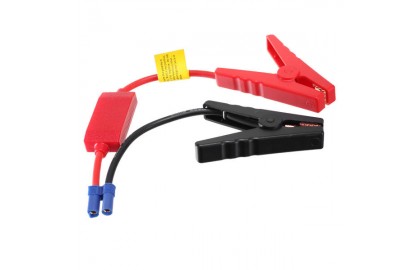Elecdeer Emergency Lead Cable for Car Trucks Jump Starter


The main body of the vehicle's emergency power supply is a battery. Its most basic function is to store electrical energy. When the vehicle battery is frozen or faulty, it can be used as a starting car, truck, ship, etc. without any AC power supply. The voltage is 12 volts. the startup system. At present, cars and trucks need to provide 12 volts from the car's own battery when the engine is started. When the car's battery is unavailable, the car cannot be started. At this time, the emergency power supply can be used instead of the car's own battery to start the car. The current emergency power supply can also have many other rich functions and become an emergency power supply in a broader sense. For example, it can charge mobile phones and other electrical appliances, can be used as lighting, and can provide power for notebooks; The tires are inflated; with an inverter, it can also output 220 volts to power other electrical appliances. When choosing a product, it should be noted that a good emergency power supply should be easy to maintain first, or even require no maintenance. The battery has a long life and can adapt to harsh working conditions. For example, some products can work normally within a large temperature difference range.
Table of contents
1 The working principle of the vehicle emergency power supply
2 Classification of vehicle emergency power supply
3 Purchase Notes
1 Working principle of vehicle emergency power supply
The emergency power supply adopts single inverter technology, which integrates charger, battery, inverter and controller.
(1) When the mains is normal, the mains supply power to the important loads through the mutual investment device, and at the same time, the mains detection and battery charging management are carried out, and then the battery pack provides DC energy to the inverter. Here, the charger is a low-power DC power supply that only needs to provide a charging current equivalent to 10% of the battery pack capacity (Ah) to the battery pack, and it does not have the ability to directly supply DC power to the inverter.
At this time, the city power supplies power to various emergency loads of users through the power supply system composed of the AC bypass of the EPS and the transfer switch. At the same time, under the control of the EPS logic control board, the inverter stops working and is in an automatic shutdown state. Under this condition, the power actually used by the user's load is the mains power from the power grid. Therefore, the EPS emergency power supply is usually said to always work in the sleep state, which can effectively achieve the effect of energy saving.
(2) When the mains power supply is interrupted or the mains voltage exceeds the limit (±15% or ±20% of the rated input voltage), the mutual switching device will immediately switch to the inverter for power supply, with the support of the DC energy provided by the battery pack. , At this time, the power used by the user load is the AC power converted by the inverter of the EPS, rather than from the mains.
(3) When the mains voltage returns to normal operation, the EPS control center sends a signal to automatically shut down the inverter, and at the same time, it also performs the switching operation from the inverter power supply to the AC bypass power supply through its transfer switch. After that, the EPS also charges the battery pack through the charger while supplying commercial power to the load through the AC bypass power supply path.
2 Classification of vehicle emergency power supply
The emergency lighting power supply is a state in which the normal power supply no longer provides the minimum brightness required for normal lighting, that is, when the voltage of the normal lighting power supply drops below 60% of the rated voltage, it is switched to the emergency lighting power supply for power supply. Emergency lighting power sources can be roughly divided into the following types:
(1) A feeder line where the power grid is effectively separated from the normal power source.
(2) Diesel generator set.
(3) Combined power supply: that is, a combination of any two or even three of the above power supplies.
(4) Battery pack: It is further divided into the following situations:
A. The lamp has its own battery, that is, the emergency lamp with its own power supply.
B. Centralized battery pack.
C. Battery packs set centrally in partitions.
3 Purchase Notes
1) The number of input channels, whether it is dual input or single input.
2) Enter the number of phases, whether it is single-phase or three-phase.
3) The total load capacity refers to the total load capacity of an EPS emergency power supply.
4) The type of load refers to whether it is used for lighting or power, and what kind of load is there.
5) How long can the emergency backup last.
6) The number of output branches, which refers to how many circuits are required to be output.
7) The position and method of the incoming and outgoing wires and the size of the incoming and outgoing wires indicate whether there are special requirements for the incoming and outgoing wires.
8) Other requirements refer to any requirements other than the above requirements.
9) Whether the fire linkage and the number of branches are required.
Get your New cable here
